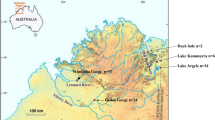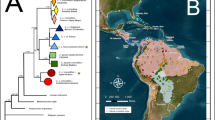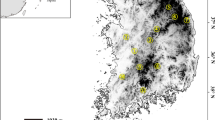Abstract
The saltwater crocodile (Crocodylus porosus) is the largest and most broadly distributed crocodilian species, and thus is of special conservation and economic interest. Similar to other parts of its range throughout the Indo-Pacific, C. porosus distributed in the Republic of Palau have experienced a severe population decline over the past century primarily due to commercial hunting and eradication campaigns. In addition, several thousand crocodiles of undocumented species and origin were imported into Palau during the 1930’s for commercial farming purposes, potentially polluting the gene pool of the endemic saltwater crocodiles. Analysis of 39 individuals collected throughout the Republic of Palau revealed a single mitochondrial DNA control region haplotype shared by populations sampled in Sulawesi, Borneo and Australia. The mtDNA results, in combination with microsatellite genotypic data at six loci, detected no evidence for inter-specific hybridization between endemic Palauan C. porosus and potentially introduced Crocodylus species. There was no evidence for a genetic bottleneck in the Palauan population, however an excess of rare alleles was identified, indirectly suggesting a recent history of admixture potentially linked to introductions of non-native C. porosus. Following from these findings, Palauan C. porosus should be included in the single ESU previously established for all saltwater crocodiles given the recovery of a fixed, but geographically widespread haplotype. Although Palauan C. porosus exhibited significant genetic differentiation relative to all other sampled populations, it’s delineation as a distinct management unit is precluded at the present time by evidence that the genetic integrity of the population may have been compromised by the introduction of non-native saltwater crocodiles.



Similar content being viewed by others
References
Belkhir K, Borsa P, Chikhi L, Raufaste N, Bonhomme F (2001) Genetix, logiciel sous Windows TM pour la génétique des populations. Laboratoire Génome, Populations, Interactions, CNRS UPR 9060. Université de Montpellier II, Montpellier (France)
Brazaitis P, Eberdong J, Brazaitis PJ (2003) The Saltwater Crocodile, Crocodylus porosus in the Republic of Palau: results of field investigations: 2 to 20 June 2003. A Special Report to the United States Fish and Wildlife Service and The Nature Conservancy, 103 pp (unpublished)
Clement M, Posada D, Crandall KA (2000) TCS: a computer program to estimate gene genealogies. Mol Ecol 9:1657–1659
Cornuet JM, Luikart G (1996) Description and power analysis of two tests for detecting recent population bottlenecks from allele frequency data. Genetics 144:2001–2014
Cornuet JM, Piry S, Luikart G, Estoup A, Solignac M (1999) New methods employing multilocus genotypes to select or exclude populations as origins of individuals. Genetics 153:1989–2000
Crombie RI, Pregill GK (1999) A checklist of the herpetofauna of the Palau Islands (Republic of Belau), Oceania. Herpetological Monographs 13:29–80
Dieringer D, Schlotterer C (2003) Microsatellite Analyser (MSA): a platform independent analysis tool for large microsatellite data sets. Mol Ecol Notes 3:167–169
FitzSimmons NN, Tanksley S, Forstner MRJ, Louis EE, Daglish R, Gratten J, Davis S (2000) Microsatellite markers for Crocodylus: new genetic tools for population genetics, mating system studies and forensics. In: Gordon C. Grigg, Frank Seebacher, Craig Franklin (eds) Crocodile biology and evolution. Surrey Beatty and Sons, Brisbane, Australia, pp 51–57
Gratten J (2003) The molecular systematics, phylogeography and population genetics of Indo-Pacific Crocodylus. Dissertation, University of Queensland
Goodman SJ (1997) Rst Calc: a collection of computer programs for calculating estimates of genetic differentiation and gene flow from microsatellite data and determining their significance. Mol Ecol 6:881–885
Guo SW, Thompson EA (1992) Performing the exact test of Hardy–Weinberg proportions for multiple alleles. Biometrics 43:805–811
Luikart G, Cornuet JM (1998) Empirical evaluation of a test for identifying recently bottlenecked populations from allele frequency data. Conserv Biol 12:228–237
Messel H, King FW (1991) Survey of the crocodile populations of the Republic of Palau, Caroline Islands, Pacific Ocean, 8–24 June 1991: A report to the government of the Republic of Palau, Koror, Palau, 49 pp (unpublished)
Moritz C (1994) Defining “Evolutionary Significant Units” for conservation. Trends Ecol Evol 9:373–375
Nei M (1987) Molecular evolutionary genetics. Columbia University Press, New York
Nei M, Roychoudhury AK (1974) Sampling variances of heterozygosity and genetic distance. Genetics 76:379–390
Piry S, Luikart G, Cornuet JM (1999) BOTTLENECK: a computer program for detecting recent reductions in the effective population size using allele frequency data. J Heredity 90:502–503
Posada D, Crandall KA (1998) MODELTEST: testing the model of DNA substitution. Bioinformatics 14:817–818
Pritchard JK, Stephens M, Donnelly P (2000) Inference of population structure using multilocus genotype data. Genetics 155:945–959
Rannala B, Mountain JL (1997) Detecting immigration by using multilocus genotypes. Proc Natl Acad Sci USA 94:9197–9221
Ray DA, Densmore L (2002) The crocodilian mitochondrial control region: general structure, conserved sequences, and evolutionary implications. J Exp Zool 294:334–345
Raymond M, Rousset F (1995) GENEPOP (v. 1.2): a population genetics software for exact tests and ecumenicism. J Heredity 86:248–249
Rice WR (1989) Analysing tables of statistical tests. Evolution 43:223–225
Ross JP (ed) (1998) Crocodiles. Status survey and conservation action plan, 2nd edn. IUCN/SSC Crocodile Specialist Group. IUCN, Gland, Switzerland and Cambridge, UK, viii + 167 pp
Russello M, Calcagnotto D, DeSalle R, Amato G (2001) Characterization of microsatellite loci in the endangered St. Vincent Parrot, Amazona guildingii. Mol Ecol Notes 1:162–164
Schneider S, Roessli D, Excoffier L (2000) Arlequin v2.000: A software for population genetics data analysis. Genetics and Biometry Laboratory, University of Geneva, Switzerland
Swofford DL (2002) PAUP*: Phylogenetic analysis using Parsimony, v.4.0b10. Illinois Natural History Survey, Champaign
Templeton AR, Crandall KA, Sing CF (1992) A Cladistic analysis of phenotypic associations with haplotypes inferred from restriction endonuclease mapping and DNA sequence data .3. Cladogram estimation. Genetics 132:619–633
Weir BS, Cockerham CC (1984) Estimating F-statistics for the analysis of population structure. Evolution 38:1358–1370
Acknowledgments
A special thanks to the people of Palau for their hospitality and graciousness over the course of this study. We would like to particularly thank Mr. Joshua Eberdong, and the Bureau of Marine Resources, Republic of Palau, for their extensive field and logistical support and our Palauan field colleagues, Mr. Harvey Kloulechad and Mr. Theodore Ngiramelekei, who took great personal risks in securing the field-sampled materials. Nancy FitzSimmons kindly provided replicate samples for calibrating the genotypic datasets and offered insightful comments that greatly improved this work. Peter John Brazaitis and Julian Dendy assisted us in the field, and Chaz Hyseni and Greg Mulvey aided in the collection of molecular data for this study. We wish to acknowledge the Peabody Museum of Natural History, National Museum of Natural History, and Field Museum of Natural History for providing access to their collections. Additionally, the St. Augustine Alligator Farm, and the Gladys Porter Zoo supplied blood samples from their extensive animal collections. George Amato and Kent Vliet provided assistance in multiple capacities, and Sarah Klain, Bureau of Marine Resources, Koror, Palau graciously prepared the locality map in Figure 1. This work was supported by the U.S. Fish and Wildlife Service’s Pacific Islands Coastal Program Grant # 122005M020.
Author information
Authors and Affiliations
Corresponding author
Rights and permissions
About this article
Cite this article
Russello, M.A., Brazaitis, P., Gratten, J. et al. Molecular assessment of the genetic integrity, distinctiveness and phylogeographic context of the Saltwater crocodile (Crocodylus porosus) on Palau . Conserv Genet 8, 777–787 (2007). https://doi.org/10.1007/s10592-006-9225-7
Received:
Accepted:
Published:
Issue Date:
DOI: https://doi.org/10.1007/s10592-006-9225-7




